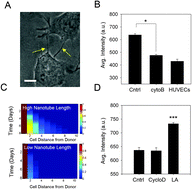Control of the interface between heterotypic cell populations reveals the mechanism of intercellular transfer of signaling proteins†
Abstract
Direct intercellular transfer of cellular components is a recently described general mechanism of cell–cell communication. It is a more non-specific mode of intercellular communication that is not actively controlled by the participating cells. Though membrane bound proteins and small non-protein cytosolic components have been shown to be transferred between cells, the possibility of transfer of cytosolic proteins has not been clearly established, and its mechanism remains unexplained. Using a cell–cell pair of metastatic melanoma and endothelial cells, known to interact at various stages during cancer progression, we show that cytosolic proteins can indeed be transferred between heterotypic cells. Using precise relative cell patterning we provide evidence that this transfer depends on extent of the interface between heterotypic cell populations. This result is further supported by a mathematical model capturing various experimental conditions. We further demonstrate that cytosolic protein transfer can have important functional consequences for the tumor–stroma interactions, e.g., in heterotypic transfer of constitutively activated BRAF, a common melanoma associated mutation, leading to an enhanced activation of the downstream MAPK pathway. Our results suggest that cytosolic protein transfer can have important consequences for regulation of processes involving physical co-location of heterotypic cell types, particularly in invasive cancer growth.



 Please wait while we load your content...
Please wait while we load your content...